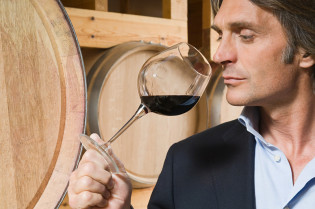How to Perform a Sensory Evaluation on Wine
To take your enjoyment of wine to the next level it is important to refine your observation skills. Much like a science experiment, you will be using all your senses to evaluate the complex beverage before you. You will use your sight to note a huge spectrum of colors and clarity in the world of wines. You will use your sense of smell to identify thousands of aromatic compounds. Your taste buds will sample complex flavors and you will actually feel the character of the wine in your mouth. And yes, there is also the sense of sound involved when we hear the cork pop, the gurgle of the wine being poured and the presence of effervescence.
Here are some simple to remember steps to perform a sensory evaluation of wine, or any beverage for that matter. I recommend you perform these steps before tasting the wine with food and taste again with the food, noting how the flavors change relative to the food you are (hopefully) enjoying. You may choose to proceed with or without the knowledge of the specific wine you are assessing. Blind-tasting is very difficult and requires a great deal of practice to identify a wine with accuracy. You may choose to taste blind just to keep your review objective and focus on whether or not you like the wine. Be sure to record your evaluations.
See – First of all, pour an amount of wine in the glass that is below the widest part of the bowl. This will allow enough room to move the wine around for your observation. When you “see” the wine you are looking for; opacity or clarity, the color hue and the difference in the “rim” variation (the rim is the thin line where the wine meets the glass). Look for flocculants (that’s a fun word for your wine vocabulary, it just means any floating or settling matter). Is the wine the color, intensity and clarity you expect? Remember, not all “floaters” effect wine negatively, decanting the wine, after resting, will deal with most solids.
Swirl – If you are new to swirling, consider keeping the base of the wine glass in contact with the table top and give it a hula-hoop-like motion. You should be able to keep the wine in the glass. At this point you want to take note of the striation of the wine on the sides of the glass. Striation happens when the alcohol and the water in the wine stream differently, creating “legs” on the bowl of the glass. How thick are the “legs” and how fast are they dissipating? This action is releasing the esters which are the volatile aromatic compounds so that you can smell them better.
Sniff – Place your nose deeply into the glass and take a short, deep sniff. At this point it is handy to have a wine aroma wheel to assist in selecting words that match what you are smelling. Are there any aromas that don’t belong, is the wine flawed? What specific aromas do you sense? How intense is the bouquet? Look for complexity and balance. Did you know that 80% of what you taste is actually defined by what you smell? This explaines why you can’t taste well when you have a cold.
Swish – Now you can finally taste the wine. Take a small amount of wine into your mouth and swish it around like mouthwash. You want to be sure the wine touches all parts of your mouth and tongue and that you allow some air to be integrated into your mouth. Your tastebuds are sectioned into specialized tasting zones to detect sweet, sour, salty, bitter and umami (savory flavors). You will also sense the weight, or the “body” of the wine on your palate. Identify any flavors that you did not notice when you first smelled the wine. Is the alcohol balanced with the fruit and acid? Do you feel a drying sensation on the sides of your mouth (the tannins)?
Spit or Swallow – This step is a personal choice. You should always have an opaque cup or vessel for spitting the wine. If it is particularly delicious, you may not want to give it up.
Savor – This is where you will make your evaluation of the wine. Take note of the length of time which the flavors linger on your palate. A long finish is a sign of a quality wine. Did you like it? You may want to start with your own 5 star rating system until you develop you vocabulary. As you practice, you will be able to discern the varietal, age and origin of the wine (something to aspire to).
Get your wine aroma wheel and wine evaluation sheet here, courtesy of the American Wine Society.
For continuing education on the of character of wine, follow my Pinterest Board: "Wine...What an Interesting Character"
Follow the American Wine Society on Facebook:



